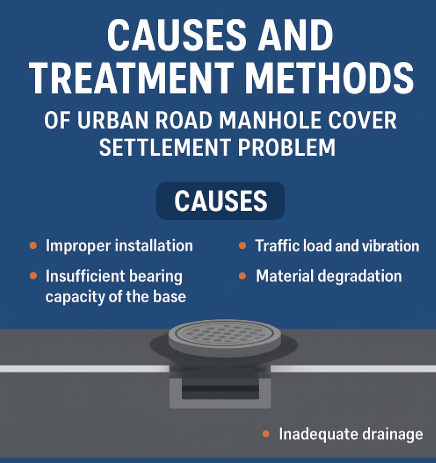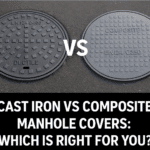Manhole cover settlement is a common issue in urban road engineering. It not only reduces driving comfort but also increases the risk of accidents and accelerates pavement deterioration. Understanding the causes of manhole cover settlement and applying effective treatment methods is essential for ensuring road safety and long-term infrastructure performance.
Causes of Manhole Cover Settlement
1. Improper Installation
Many cases of settlement occur because of poor installation practices. If the bedding material beneath the manhole cover frame is uneven or lacks proper compaction, it creates voids that lead to sinking under traffic loads.
2. Insufficient Bearing Capacity of the Base
When the foundation soil or concrete base has low strength, it cannot withstand repeated dynamic loads from vehicles. Over time, this weakness results in settlement around the manhole cover.
3. Traffic Load and Vibration
Heavy traffic, especially trucks and buses, exerts continuous dynamic pressure on road surfaces. Since manhole covers often interrupt the continuity of pavement layers, they become weak points where settlement occurs.
4. Material Degradation
Aging concrete, corrosion of cast iron frames, or erosion from water infiltration weakens structural integrity, accelerating deformation and settlement around the manhole.
5. Inadequate Drainage
Poor drainage design allows rainwater to infiltrate the soil, softening the foundation and washing away fine particles. This process significantly increases the likelihood of settlement.
Treatment Methods for Manhole Cover Settlement
1. Reinforcement of Foundation
Rebuilding or reinforcing the base with high-strength concrete, polymer mortar, or resin-based materials improves load-bearing capacity and reduces settlement risk.
2. Optimized Installation Practices
Using precision leveling techniques and proper compaction during installation ensures stability. Prefabricated adjustable manhole seats are increasingly adopted to guarantee accuracy.
3. Improved Material Selection
Lightweight composite manhole covers combined with high-durability frames reduce stress concentrations. Additionally, anti-corrosion coatings extend service life.
4. Application of Flexible Pavement Joints
By incorporating flexible sealing rings or asphalt transitions around manhole covers, engineers can better distribute traffic loads and absorb vibrations.
5. Drainage Enhancement
Upgrading drainage channels around manholes prevents water accumulation. Surface slope adjustments also ensure proper runoff and minimize infiltration.
Preventive Measures for Long-Term Performance
Regular inspection and timely maintenance remain essential for preventing recurrence. Implementing digital monitoring tools, such as load sensors or settlement detectors, allows engineers to track performance and respond quickly to early signs of deformation.
Conclusion
The settlement of urban road manhole covers is a multifaceted problem influenced by installation, traffic, materials, and drainage. However, by combining proper design, advanced materials, and modern maintenance strategies, cities can significantly reduce risks, enhance road safety, and extend pavement life. Proactive treatment not only saves repair costs but also improves the overall driving experience for urban residents.





